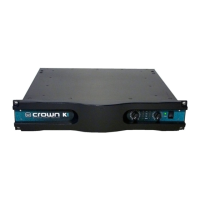K Series Service ManualRev A.
Maintenance 5-7
©1999 Crown International, Inc.
the Main PWA). Using the chassis as the ground refer-
ence, pin 3 is +15VDC and pin 12 is –13VDC. If the
both voltages are correct, discharge power supplies,
then plug Output PWA back in, and unplug the other
Output PWA. Repeat test. If one or both of the DC
voltages is not correct then repair or replace the Main
PWA.
No Signal; one or both channels. Enable on. IOC on.
A constant IOC condition indicates a problem in the
signal path including the Error Amp circuit. This in-
cludes the Main and Output PWA’s. The problem most
likely exists on the Main PWA.
No Signal; one or both channels. Enable light only.
The problem most likely exists on the Input PWA. If
the Input PWA proves to not be the problem then the
Main PWA is at fault.
To check the Input PWA, inject a signal into the chan-
nel at fault and turn the level control up. Locate U103
(Ch1) or U203 (Ch2). With an oscilloscope check to
see if there is signal at pin 8. If there is no signal at this
point discharge the supplies, then repair or replace
the PWA. If there is signal then check U5 pin 13 with a
DC volt meter. If this pin is at –13VDC then the signal
detect circuit is not working. Discharge the supplies,
then repair or replace the Input PWA. If you find signal
at U103/203 pin 8, and U5 pin 13 is high (0 VDC), then
the Input PWA is OK. Discharge the supplies, then
repair or replace the Main PWA.
Distortion; one or both channels. IOC indication.
The problem most likely exists on either the Output
PWA or Main PWA. Check the Output PWA first. If the
Output PWA checks out, repair or replace Main PWA.
Distortion; one or both channels. No IOC.
The problem most likely exists on the Input PWA. First
check levels on affected channels, no load. If levels
check out, discharge the supplies, then repair or re-
place Input PWA.
Amplifier does not meet power specs.
Check your power source. If the AC voltage sags be-
low the specified operating voltage of the amplifier then
the unit will not produce full rated output.
The large power supply filter capacitors located on the
Output PWAs are wired in parallel from one PWA to the
other. If one or more of these capacitors has a broken
solder joint it could result in the amplifier not meeting
power specifications. To check the capacitors, dis-
charge the supplies, then remove the Output Assem-
bly. Wiggle the capacitors back and forth. If they ap-
pear to be loose then they are bad. Repair or replace
Output PWA.
Check the Main Wiring Harness. Multiple wires are used
in parallel to handle the high supply currents. If one or
more of these wires is broken then it will result in re-
stricted current. This could result in the amplifier not
meeting power specifications.
Frequency Response out of tolerance.
The problem most likely exists on the Input PWA. The
Input PWA has the EQ circuit for a flat response. If this
circuit is faulty the amplifier will have poor frequency
response. Discharge the supplies, then repair or re-
place Input PWA.
Voltage gain problems.
If you experience voltage gain problems with no dis-
tortion, the problem most likely exists on the Input
PWA. The Input Sensitivity/Gain Stage circuitry is lo-
cated on the Input PWA. Discharge the supplies, then
check the Input PWA. If it is faulty, repair or replace
PWA. If Input PWA checks out, the problem is likely
on the Display PWA, which includes the Level Control
Pots. Discharge the supplies, then check Display
PWA. If Display PWA is faulty, repair or replace PWA.
If you have gain problems with distortion, resulting in
an IOC condition, then the problem most likely exists
on the Main PWA. Discharge the supplies, then check
Main PWA. If faulty, repair or replace PWA.
Amplifier gets extremely warm at idle.
Sleep Mode is indicated on the front panel by the En-
able indicator. When it switches to half intensity then
the amplifier is in sleep mode. It takes approximately
6 seconds after the signal is removed before the am-
plifier goes into Sleep Mode. Note that any signal at
all, even a small one, will keep the amplifier out of
sleep mode and it will get warm to the touch. If, with no
signal at all, the amplifier never goes into Sleep Mode
then the problem most likely exists on the Input PWA.
The Signal Detect circuit for Sleep Mode is located on
the Input PWA. Discharge the supplies, then check
Input PWA. If faulty, repair or replace PWA.
To verify the operation of the Signal Detect Circuit, lo-
cate U5 on the Input PWA. Monitor pin 13 with a DC
volt meter referenced to chassis ground. If it switches
to –13VDC 6 seconds after signal is removed then the
circuit is OK. If this circuit is OK, but the amplifier
never goes to Sleep, then the problem exists on the
Main PWA. Discharge the supplies, then repair or re-
place Main PWA.
Amplifier consistently trips breakers at turn on.
A Soft Start circuit on the Control PWA limits the amount

